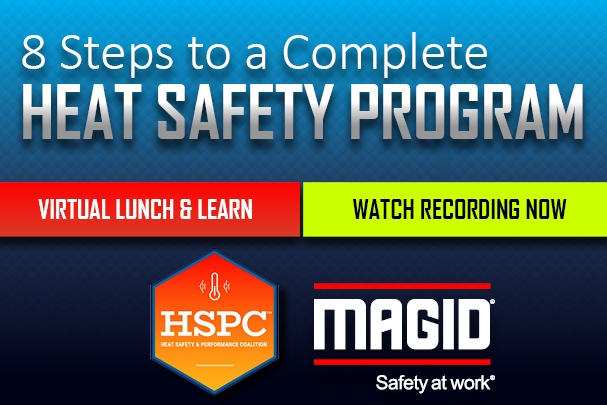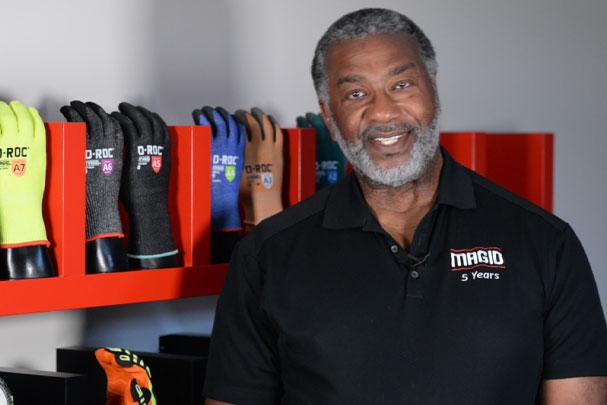
Keeping Workers Safe in Extreme Temperatures
By M.B. Sutherland, Sr. Safety Writer, Magid
If you’re feeling too hot or too cold, it’s only natural to want to level out. But when hazardous jobs meet extreme temperatures, that urge can spell trouble as workers cut corners to get comfortable. Keeping comfort in mind when choosing protective clothing for extreme cold or heat can mean the difference between worker safety and workers taking risks.


Winter Safety Tips for Keeping Warm in Extreme Cold
Whether the cold comes from Mother Nature or a walk-in freezer, workers are more likely to stay safe if you choose protective clothing that keeps them both warm and comfortable. Highlight these types of clothing alongside other cold weather safety tips during toolbox talks or safety training presentations.


Layer Up – But Do It Right
Multiple, heavy layers keep people warm while they’re sitting still, but most jobs require workers to move and sweat. It’s important to avoid heavy layers that restrict movement, but you also need to provide a base layer of clothing that’s made of moisture-wicking material. These special fabrics move moisture to the clothing’s surface and away from the wearer’s skin so they don’t end up shivering with a damp t-shirt under their safety gear.


Warm Layers for Electrical Work
Many workers take advantage of moisture-wicking athletic clothing as a base layer in the cold. But it’s important to remind them that the gear they wear to the gym is not appropriate in an electrical environment. Nylon or polyester t-shirts are great for keeping the sweat off during a workout, but they can be a disaster in an electrical accident. Even when worn underneath other arc-flash-rated clothing, synthetic fabrics can melt to the wearer’s skin in an arc-flash incident, causing potentially life-threatening burns. Keep in mind that any layering for electrical work should include an arc-rated base where appropriate.
Summer Safety Tips for Keeping Cool in Extreme Heat
Overheating can cause workers to lose concentration, make mistakes, and can even lead to heat illness. Even worse, 11 U.S. workers are seriously injured or die from heat stress every day. So when a job needs protective clothing in a hot environment, it’s important to find breathable options that keep workers as cool as possible. Bring in samples of these protective clothing options during heat illness prevention safety trainings, as well.


Clothing that Releases Heat
Many jobs that involve electricity, fire, or chemicals require workers to wear full-body protection like arc-rated or chemical-resistant coveralls. New fabric technologies are being incorporated into coveralls to provide knit panels at the back and underarms and even down the length of arms and legs that release heat and lower the wearer’s core temperature. And just as a moisture-wicking base layer is important in the cold, the same type of garment worn under a coverall is perfect for indoor or outdoor environments that are hot.
For workers who don’t need all-over coverage, you can still choose protective clothing made from light, moisture-wicking materials to keep them cool. In extremely hot environments, you can even choose cooling vests with cool-pack compartments built in to keep the worker’s core temperature lower through the day. Keep in mind that these garments are not meant to make workers feel cool as much as they’re designed to keep their core temperature from rising to dangerous levels – so they may not think the garment is cooling them, but it is!


Clothing that Protects from Heat
More intense heat requires heavier protection, but that doesn't necessarily mean you have to surround your workers in a full-body shield. Choose gear that keeps them safe for single-sided hazards like sparks or radiant heat but helps them stay cooler with coverage only where it's needed. So look for welding jackets with protective fronts and sleeves along with a mesh back to release body heat. For the lower body, try aluminized chaps to protect against molten metal while keeping the backs of the legs cooler


Body-Cooling PPE
For workers in hot and humid microclimates or workers who perform heavy exertional tasks, the latest body-cooling PPE can help keep a hot day from becoming a disaster. Magid® Cool Powered by Mission® products provide body-cooling that’s portable, instant, and lasts up to two hours. Workers can suffer serious heat illnesses like heat stroke even on warm days without direct sunlight, so emphasizing that they wear the right cooling PPE can help them keep the heat in-check.




Remember, no matter what your environment, keeping workers comfortable goes hand in hand with keeping them safer!







